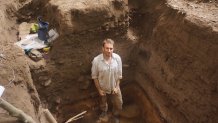
Experts analysed the DNA of twenty people found in the two rock-shelters, dating from 9,600-3,700 years ago
Human migration from South America back into Mesoamerica thousands of years ago led to the spread of intensive farming methods across the region, according to a new study.
Human migration from South America back into Mesoamerica thousands of years ago led to the spread of intensive farming methods across the region, according to a new study.
5,600 years ago a previously unknown movement of people from South America into Mesoamerica had a major demographic impact, researchers have found. Those who moved northward were responsible for 50 per cent of the ancestry of all later individuals in the region, including present-day Chibchan speakers living from Costa Rica to Colombia. They transformed subsistence practices, with profound impacts on the diversity of American cultures and landscapes.
Until now the genetic prehistory of human populations in the Americas had been largely unexplored due to the lack of preserved human skeletons, leaving an important gap in our knowledge of the global expansion of humans.
The unparalleled discovery of well-preserved human skeletons in two rock shelters in a remote Belizen jungle provided the first opportunity for archaeologists to analyse changing human genetic populations and dietary practices. Experts analysed the DNA of twenty people found in the two rock-shelters, dating from 9,600-3,700 years ago. The oldest individuals (who lived between 9,600-7,300 years ago) descend from an Early Holocene Native American lineage and are only distantly related to present-day Mesoamericans, including Mayan-speaking populations.
Skeletons dating between 5600 and 3700 years ago, showed distinctly different genomes from the earlier individuals, sharing ancestry with Chibchan populations from southern Central America and northern South America. Suggesting a northward movement of people from the south into Mesoamerica.
The arrival of this southern genetic population coincides with the first evidence of a number of South American crop plants, including chili peppers, manioc, and domesticated maize, suggesting that these plant technologies and farming methods were introduced with the spread of this human genetic population.
Maize (corn) was initially domesticated 9,000 years ago from the wild grass, Teosinte, in Central Mexico. This technology spread to South America by 7,500 thousand years ago, where it underwent secondary improvement through the selection of desirable traits by humans, such as kernel size. These improved varieties are the basis for all the maize we grow and consume today, from animal fodder to our cinema popcorn.
Until now, how this important global crop spread was unknown, but analysis of the Belizean skeletons reveal that the movement of people drove this process. The study says Chibchan-related horticulturalists moved northward into the Mesoamerica carrying improved varieties of maize, and possibly also manioc and chili peppers, and mixed with local populations to create new horticultural traditions that led to more intensive forms of maize agriculture around 4,700 years ago.
Dr Mark Robinson, from the University of Exeter), who was part of the team that discovered and excavated the burials, said: "These findings are revealing the history of the Americas and globally important crops. What we can previously only speculate upon, now has scientific evidence".
The research, published in the journal Nature Communications, was carried out by Douglas J. Kennett and Richard J. George from the University of California, Santa Barbara; Mark Lipson and Nadin Rohland and David Reich from Harvard University; Keith M. Prufer, Ethan C. Hill, Erin E. Ray, Paige Lynch, Emily Moes and Heather H. J. Edgar from University of New Mexico, Albuquerque; David Mora-Marín from University of North Carolina, Chapel Hill; Mark Robinson from the University of Exeter; Willa R. Trask from the Central Identification Laboratory; Lexi O'Donnell from the University of Mississippi; Thomas K. Harper, Brendan J. Culleton and Timothy M. Ryan from The Pennsylvania State University; Emily J. Kate from University of Vienna; Josue Ramos, Jaime J. Awe and John Morris from the Belize Institute of Archaeology and Said M. Gutierrez from Ya'axché Conservation Trust.






